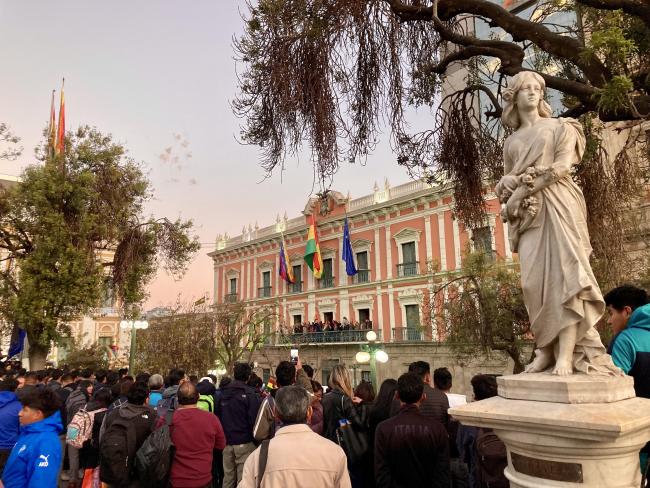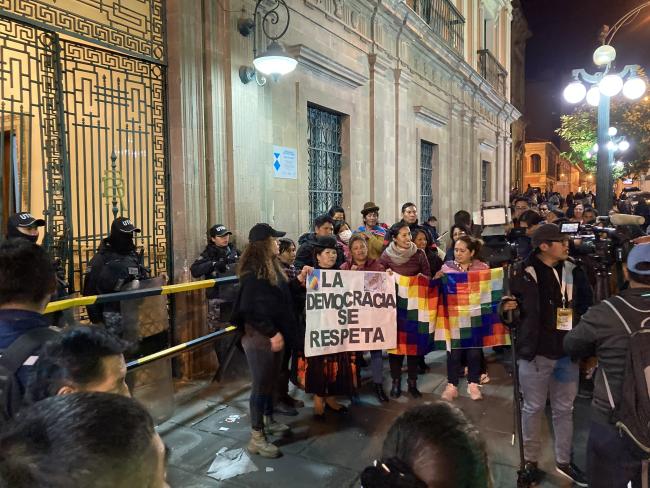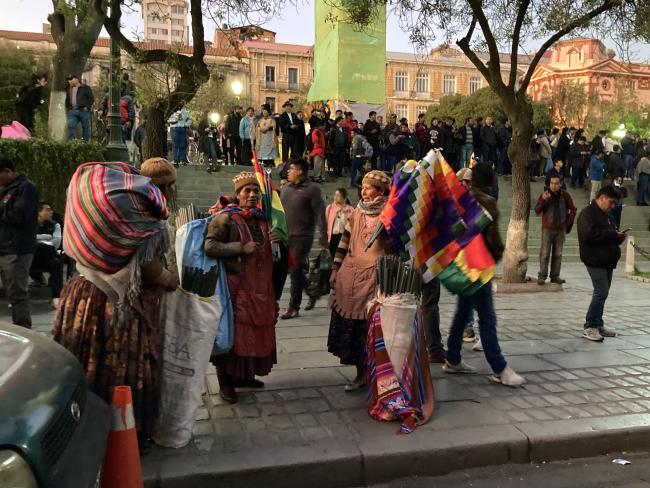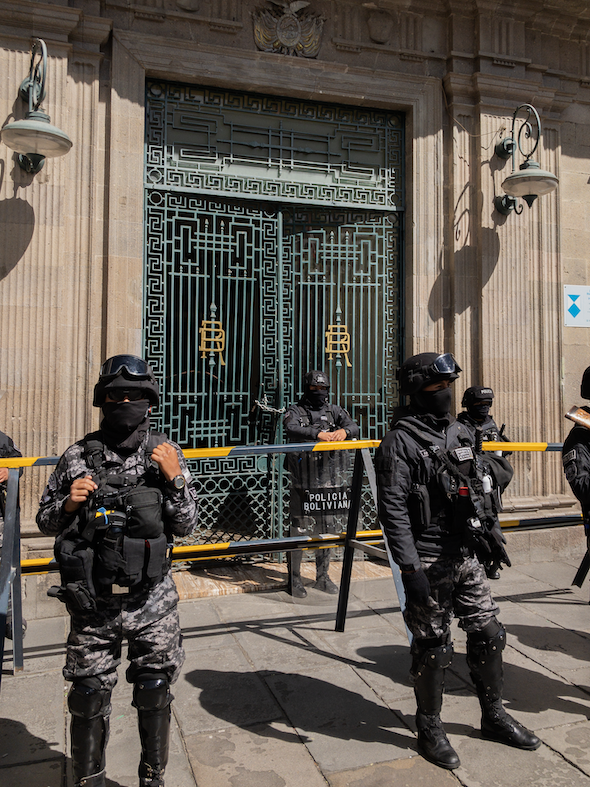
On Wednesday, June 26, at 2:30 pm local time, tanks stormed La Paz’s Plaza Murillo, the center of government in Bolivia. The President Luis Arce’s administration labeled the incursions, led by the commander of the Army, General Juan José Zúñiga, “irregular mobilizations.” The spark for the military’s actions was the removal of Zúñiga from his post the previous day, following his televised June 24 comments about former president Evo Morales. “[Morales] can no longer be president of this country,” Zúñiga stated, adding that he would not allow “the constitution to be trampled, to disobey the mandate of the people.”
As soldiers filled the plaza, Zúñiga told the press that the Armed Forces “wanted to establish democracy.” “There will be a new cabinet of ministers… our state cannot continue like this,” Zúñiga added. “We want to recover our homeland. [We have had] enough of the impoverishment of our homeland.”
Armored vehicles then rammed the doors of the historical presidential palace, known as the Palacio Quemado. In an extraordinary scene that would not have been out of place in a telenovela, President Arce faced down the leader of the so-called coup plot. An air of tension descended upon the sister cities of La Paz and El Alto. People left their jobs early, and long queues formed outside gas stations and cash machines. The Bolivian Workers’ Central (COB), the leading trade union in the country, and the peasants confederation, the CSUTCB, announced a national strike, and people took to the streets in the city center, marching towards Plaza Murillo.
At around 5:00 pm, Arce addressed the Bolivian people from the Casa Grande del Pueblo, the seat of the executive. “The country today is facing an attempted coup d'état… We need the Bolivian people to organize against the coup d'état, in favour of democracy,” he said. “We cannot allow coup attempts to take Bolivian lives. We want to urge everyone to defend democracy.” He appointed a new military high command, with José Sánchez as commander of the Army, Gerardo Zabala the commander of the Air Force, and Renán Guardia the commander of the Navy.
And then, just as suddenly as it had begun, it was all over. Zúñiga fled Plaza Murillo in his tank before being swiftly apprehended by the police. Arce and his ministers addressed the crowds that had flooded into Plaza Murrillo following Zúñiga’s exit, chanting Arce’s name. “With you, with the people, we will never give up,” proclaimed the president to the jubilant crowds. “Nobody can take away the democracy that we have won at the polls and with the blood of the Bolivian people.”
Were these the actions of a desperate man, or was there a broader political calculus behind Zúñiga’s incursion?
As the dust settled and the tension ebbed, memes about surviving the coup d’état of 2024 circulated on social media. If the 2019 political crisis that ousted former president Evo Morales was a tragedy that shook Bolivian society to its core, the events of June 2024 were history repeating itself as a farce.
If this was a serious attempt to seize power through a coup d’état, at first glance it appears to have been seriously poorly thought out. Zúñiga had no political allies behind him, and in the hour following the storming of Plaza Murrillo, politicians of all stripes took to social media to condemn the military’s actions. From Arce and Morales of the Movement Toward Socialism (MAS) party, to the old stalwarts from the neoliberal period, to leaders Luis Fernando Camacho and Jeanine Áñez, both imprisoned for their part in the 2019 coup, everyone was apparently against Zúñiga.

Crisis and Political Impasse
Zúñiga’s incursion comes amid a brewing economic crisis and a political struggle that is playing out almost exclusively inside one political party: the MAS of Arce and Morales.
On the one hand, falling gas prices and production volumes, coupled with a fracking boom in Argentina and the failure of Bolivia’s lithium industry to take off, have reduced the country’s supply of foreign reserves. A macroeconomic strategy to stave off inflation using existing reserves was successful at keeping inflation at bay during the past couple of years. However, this has depleted foreign reserves to such an extent that there are now no dollars. Bolivians face shortages of certain goods, and inflation is on the rise. Unsurprisingly, economic crisis looms large in the public imagination.
On the other hand, since 2019 there has been no oppositional force to the MAS. While in 2019, large protests accompanied the maneuvers of Camacho, Áñez, and the military to remove Morales from office, anti-government demonstrations were entirely absent on June 26. Opposition political parties have no new proposals and offer no alternative to the status quo. Although leaders from the neoliberal period of the 1990s and early 2000s bang the drum of how bad the MAS is, these accusations don’t land well among voters who have seen unquestionable transformations of their everyday lives under Morales and Arce’s rule.
The MAS and the Political Landscape
The real political struggle is between Arce and Morales, and this is where Zúñiga enters the frame. With elections approaching in 2025, there has been a war of words between the two since October 2023. At the MAS Congress that month, where party delegates met to decide the party’s electoral strategy, Morales called Arce “a cash machine” as he was ejected from the party. Arce’s expulsion paved the way for Morales’s controversial selection as the MAS presidential candidate.

In March, Morales reaffirmed his intention to run for president on the MAS ticket. His core supporters are the coca growers and their federations, from whose ranks he rose to become president the first time around, winning his first election in 2005. The coca growers view the MAS as their political instrument given its origins in debates within the peasant confederation, the CSUTCB, in the 1980s.
Following his expulsion from the party, Arce has tried to maintain his grip on power by organizing a parallel MAS, a classic tactic normally used by the MAS to control social movements. He and his government have tried to prevent Morales from running. In December of last year, the country’s constitutional court revoked a previous ruling enabling Morales to run indefinitely, disqualifying him from running in 2025.
The rancor between Arce and Morales has spilled over into different organs of the state, pitting the legislature against the judiciary. Earlier this month, a parliamentary session led by Morales’s ally Andrónico Rodríguez attempted to suspend all the country’s magistrates. The constitutional court hit back, declaring the law illegal as it was put forward by Rodríguez, the head of the Senate, rather than David Choquehuanca, vice president and head of the parliament.
The result has been a political impasse making everyday governance nearly impossible. The rivalry has shone a light on Bolivia’s electoral and constitutional apparatuses once again, apparently provoking Zúñiga and parts of the Bolivian military into action.

Three Theses
There are three competing theories about how to understand the events of June 26. The first theory is that these were actions of a rogue general, bitter about the loss of his post as the head of the Bolivian Armed Forces. Zúñiga acted alone and on a whim, taking advantage of a delay in communication regarding his dismissal to mobilize his forces against Arce.
The second theory is that Arce was the mastermind behind the attempt, and that these events represented an autogolpe (self-coup). Following his arrest, Zúñiga stated that he had met with Arce on June 23 and that Arce said to him: “The situation is a mess [muy jodida] and this week is going to be critical. Therefore, we need to prepare something that will boost my popularity.” In other words, according to this theory, the military’s entrance into Plaza Murillo was a spectacle designed to galvanize support in the face of the political crisis provoked by Morales. The bizarre confrontation between Arce and Zúñiga in front of the press and the speeches given from the balcony of the Palacio Quemado following the military’s exit seem to suggest this.
The final theory is that Morales was behind it, to make Arce look weak and capable of an autogolpe, something that in Latin American history has been used by strongman leaders (caudillos) to consolidate power. The most vocal proponents of the autogolpe thesis have been Morales and his support base, the coca growers of the Chapare region. According to this theory, the political crisis of this week is one of Morales’s making, and it is not inconceivable that the spectacle was not all that it seemed.
The trouble is that none of these theories make complete sense. If the first theory is true, why would Zúñiga, a man capable of leading a highly disciplined force, act so rashly and without a plan? If the second is accurate, why would Zúñiga state his actions to be an autogolpe upon arrest? Surely that would have been part of the plan. And if Morales was behind it, why did the interactions between Zúñiga and Arce seem so staged, and the speeches afterwards so scripted?
At the moment, we remain in the dark about the precise causes of this week’s drama. What is clear, however, is that the political struggle within the MAS is radiating beyond the confines of the party itself and has the potential to further destabilize Bolivia’s already fragile democratic institutions.
Angus McNelly is a Senior Lecture in International Relations at the University of Greenwich, London, UK. He is the author of “Now We Are in Power: The Politics of Passive Revolution in Twenty First Century Bolivia” (University of Pittsburgh Press, 2023), and is currently researching the longue durée of natural resource led development in Bolivia.

